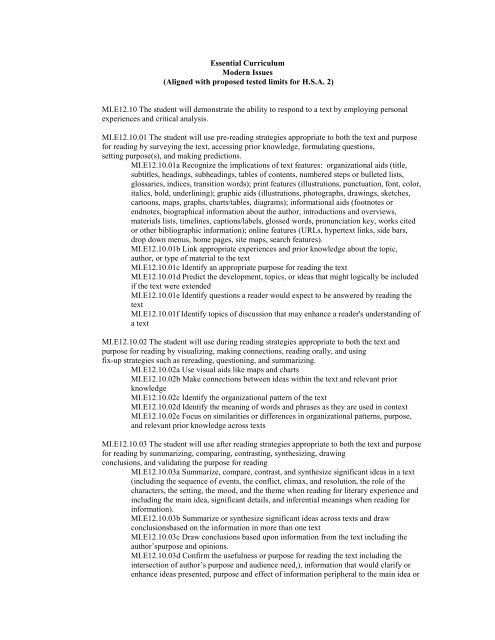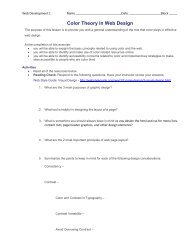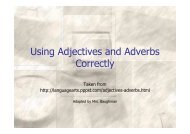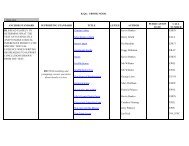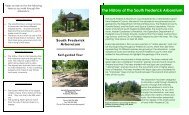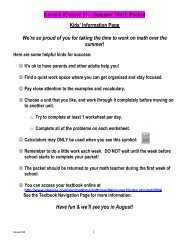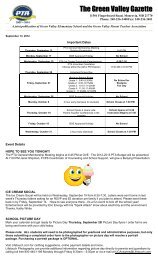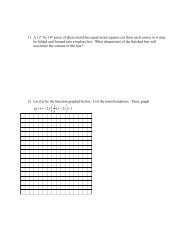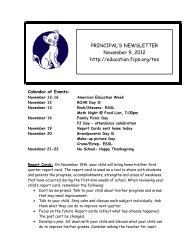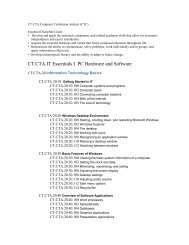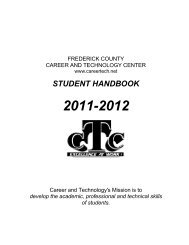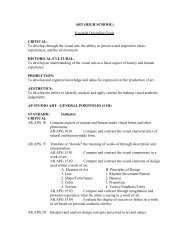Modern Issues
Modern Issues
Modern Issues
You also want an ePaper? Increase the reach of your titles
YUMPU automatically turns print PDFs into web optimized ePapers that Google loves.
Essential Curriculum<br />
<strong>Modern</strong> <strong>Issues</strong><br />
(Aligned with proposed tested limits for H.S.A. 2)<br />
MI.E12.10 The student will demonstrate the ability to respond to a text by employing personal<br />
experiences and critical analysis.<br />
MI.E12.10.01 The student will use pre-reading strategies appropriate to both the text and purpose<br />
for reading by surveying the text, accessing prior knowledge, formulating questions,<br />
setting purpose(s), and making predictions.<br />
MI.E12.10.01a Recognize the implications of text features: organizational aids (title,<br />
subtitles, headings, subheadings, tables of contents, numbered steps or bulleted lists,<br />
glossaries, indices, transition words); print features (illustrations, punctuation, font, color,<br />
italics, bold, underlining); graphic aids (illustrations, photographs, drawings, sketches,<br />
cartoons, maps, graphs, charts/tables, diagrams); informational aids (footnotes or<br />
endnotes, biographical information about the author, introductions and overviews,<br />
materials lists, timelines, captions/labels, glossed words, pronunciation key, works cited<br />
or other bibliographic information); online features (URLs, hypertext links, side bars,<br />
drop down menus, home pages, site maps, search features).<br />
MI.E12.10.01b Link appropriate experiences and prior knowledge about the topic,<br />
author, or type of material to the text<br />
MI.E12.10.01c Identify an appropriate purpose for reading the text<br />
MI.E12.10.01d Predict the development, topics, or ideas that might logically be included<br />
if the text were extended<br />
MI.E12.10.01e Identify questions a reader would expect to be answered by reading the<br />
text<br />
MI.E12.10.01f Identify topics of discussion that may enhance a reader's understanding of<br />
a text<br />
MI.E12.10.02 The student will use during reading strategies appropriate to both the text and<br />
purpose for reading by visualizing, making connections, reading orally, and using<br />
fix-up strategies such as rereading, questioning, and summarizing.<br />
MI.E12.10.02a Use visual aids like maps and charts<br />
MI.E12.10.02b Make connections between ideas within the text and relevant prior<br />
knowledge<br />
MI.E12.10.02c Identify the organizational pattern of the text<br />
MI.E12.10.02d Identify the meaning of words and phrases as they are used in context<br />
MI.E12.10.02e Focus on similarities or differences in organizational patterns, purpose,<br />
and relevant prior knowledge across texts<br />
MI.E12.10.03 The student will use after reading strategies appropriate to both the text and purpose<br />
for reading by summarizing, comparing, contrasting, synthesizing, drawing<br />
conclusions, and validating the purpose for reading<br />
MI.E12.10.03a Summarize, compare, contrast, and synthesize significant ideas in a text<br />
(including the sequence of events, the conflict, climax, and resolution, the role of the<br />
characters, the setting, the mood, and the theme when reading for literary experience and<br />
including the main idea, significant details, and inferential meanings when reading for<br />
information).<br />
MI.E12.10.03b Summarize or synthesize significant ideas across texts and draw<br />
conclusionsbased on the information in more than one text<br />
MI.E12.10.03c Draw conclusions based upon information from the text including the<br />
author’spurpose and opinions.<br />
MI.E12.10.03d Confirm the usefulness or purpose for reading the text including the<br />
intersection of author’s purpose and audience need,), information that would clarify or<br />
enhance ideas presented, purpose and effect of information peripheral to the main idea or
argument, and language used by the author to persuade the reader (emotional appeals)<br />
when reading non-fiction.<br />
MI.E12.10.03e Examine meaning by determining how the speaker, organization,<br />
sentence structure, word choice, tone, rhythm, and imagery reveal an author’s purpose.<br />
MI.E12.10.04 The student will consider the contributions of plot, character, setting, conflict, style,<br />
and point of view when constructing the meaning of a text.<br />
MI.E12.10.04a Analyze a plot sequence of events using Freitag's pyramid (including but<br />
not limited to rising action, climax, falling action, and resolution) and the cause<br />
and effect relationships among these events.<br />
MI.E12.10.04b Analyze a character's defining traits, motivations, and development<br />
throughout a text (including, static v. dynamic and flat v. round judgments, plausibility of<br />
character actions as linked to the outcome of the plot, relation to subsequent plot events<br />
and external forces, relationships between and among characters).<br />
MI.E12.10.04c Analyze the setting of a text (including, but not limited to the details that<br />
provide clues to the setting, the mood created by the setting, the role the setting<br />
plays in the text).<br />
MI.E12.10.04d Analyze the conflicts that motivate characters and the internal and<br />
external forces that drive the plot (where external conflicts are person v. person, person<br />
v. nature, person v. society, and internal conflicts are person v. himself or herself).<br />
MI.E12.10.04e Analyze the perspective of the author or speaker, as well as the effects of<br />
first or third person narration, including limited v. omniscient views.<br />
MI.E12.10.04f Examine language choices with an emphasis on simile, metaphor,<br />
personification, imagery (including sensory language), symbolism, irony, illusions, and<br />
hyperbole.<br />
MI.E12.10.05 The student will extend or further develop meaning by explaining the implications<br />
of the text for the reader or contemporary society.<br />
MI.E12.10.05a Identify ideas and issues of a text or across texts that may have<br />
implications for readers or contemporary society.<br />
MI.E12.10.05b Analyze the use and effectiveness of rhetorical devices (logical, ethical,<br />
and emotional), stylistic elements (syntax and choice of details), and rhetorical strategies<br />
(introductions, sequences, illustrations, conclusions) in a text.<br />
MI.E12.10.05c Explain connections between and among themes and styles of two or<br />
more texts.<br />
MI.E12.10.05d Interpret a work using a critical approach (e.g. reader response, historical,<br />
cultural, biographical, structural) that is supported with textual references.<br />
MI.E12.10.05e Explain how common and universal experiences serve as the source of<br />
literary themes which cross time and cultures.<br />
MI.E12.10.06 The student will identify features of language that create voice and tone<br />
MI.E12.10.06a Analyze the effects of certain words and phrases on the tone or voice of a<br />
text or across texts<br />
MI.E12.10.06b Identify similarities or differences in the overall tone created by language<br />
choices throughout a text or across texts<br />
MI.E12.10.07 Students will use a variety of strategies to critically read and discuss texts<br />
representing diversity in content, culture, authorships, and perspective.<br />
MI.E12.10.07a Read poetry, which may include haiku, form/shape poetry, cinquain,<br />
ballad, lyric, elegy, sonnet, concept, epic, odes, etc.<br />
MI.E12.10.07b Read fiction, which may include short stories, novels, novellas, vignettes,<br />
etc.<br />
MI.E12.10.07c Read non-fiction, which may include memoirs, essays, speeches, journals,<br />
biographies, autobiographies, diaries, etc.
MI.E12.10.07d Read functional documents, which may include sets of directions,<br />
brochures, science investigations, manuals, atlases, legislative documents,<br />
editorials/commentary, memos,<br />
financial documents, etc.<br />
MI.E12.10.07e Read reference materials, which may include textbooks, historical<br />
documents, newspapers, on-line websites, and search engines, etc.<br />
MI.E12.10.08 Students will read a minimum of 25 self-selected and/or assigned books or book<br />
equivalents representing various genres.<br />
MI.E12.20 The student will demonstrate the ability to compose in a variety of modes by developing<br />
content, employing specific forms, and selecting language appropriate for a particular<br />
audience and purpose.<br />
MI.E12.20.01 The student will compose persuasive texts that support, modify, or refute a position<br />
and include effective rhetorical strategies and devices.<br />
ME.E12.20.01a Form and support an opinion and challenge the opinions of others.\<br />
ME.E12.20.01b Support a position with documented information from multiple<br />
authoritative sources.<br />
MI.E12.20.02 The student will compose informative texts that establish a clear purpose, a<br />
consistent point of view, address the identified audience(s), and provide adequate development<br />
(including rhetorical devices and figurative and sensory language as appropriate).<br />
MI.E12.20.02a Description<br />
ME.E12.20.02b Explanation<br />
ME.E12.20.02c Evaluation<br />
MI.E12.20.03 The student will compose to express personal ideas, using prose and/or poetic<br />
forms.<br />
MI.E12.20.03a Write a narrative composition to entertain using the writing process, one<br />
that establishes a clear purpose, a consistent point of view, addresses the identified<br />
audience, provides adequate development, and includes the narrative elements<br />
of character, conflict, setting, and a sequential plot.<br />
MI.E12.20.04 The student will use a variety of prewriting strategies to generate and develop ideas.<br />
MI.E12.20.04a Generate ideas (e.g. through brainstorming)<br />
MI.E12.20.04b Develop ideas (e.g. through listing, free writing)<br />
MI.E12.20.04c Begin a coherent plan for composing (e.g. use of graphic organizers,<br />
gathering of relevant information sources)<br />
MI.E12.20.04d Identify relevant sources of information<br />
MI.E12.20.05 The student will select and organize ideas for specific audiences and purposes.<br />
MI.E12.20.05a Provide a logical sequence of ideas for sentences<br />
MI.E12.20.05b Choose an appropriate organizational structure to create meaning for the<br />
audience using the appropriate purpose (chronological, spatial, order of<br />
importance, comparison, and cause-effect)<br />
MI.E12.20.05c Select information based on purpose and audience<br />
MI.E12.20.05d Identify the logical placement of a sentence or paragraph within a text<br />
MI.E12.20.05e Use elaboration in multi-paragraph compositions<br />
MI.E12.20.06 The student will revise texts for clarity, completeness, and effectiveness.<br />
MI.E12.20.06a Conciseness (eliminate redundancy, superfluous words, and phrases and<br />
awkward constructions)<br />
MI.E12.20.06b Coherence (focus on a central idea or large organizational pattern)<br />
MI.E12.20.06c Clear antecedents
MI.E12.20.06d Clear placement of modifiers<br />
MI.E12.20.06e Careful placement of limiting modifiers<br />
MI.E12.20.06f Use of active or passive voice<br />
MI.E12.20.06g Clear topic and/or summary sentences<br />
MI.E12.20.06h Appropriate elaboration or use of support sentences<br />
MI.E12.20.06I Use of sentence variety and length<br />
MI.E12.20.06j Use of transitional devices between sentences and paragraphs<br />
MI.E12.20.06k Word choice (knowledge of the use of commonly confused words)<br />
MI.E12.20.06l Concrete/specific details<br />
MI.E12.20.06m Clarification of text when misplaced or dangling modifiers, clauses, or<br />
phrases are utilized.<br />
MI.E12.20.06n Elimination of mixed or incomplete sentences<br />
MI.E12.20.06o Elimination of shifts in person, number, tense, and mood<br />
MI.E12.20.06p Clarification of text through logical coordination and subordination of<br />
ideas<br />
MI.E12.20.06q Use of logical or succinct subordination in place of faulty, excessive, or<br />
awkward subordination<br />
MI.E12.20.06r Use of subordination to show space or time, cause or effect, condition,<br />
concession, purpose or identification<br />
MI.E12.20.06s Use of subordination to replace excessive coordination<br />
MI.E12.20.06t Use of parallel structure for effectiveness and to replace wordiness (e.g.<br />
both…and…; either…or)<br />
MI.E12.20.06u Use of inverted word order for effectiveness<br />
MI.E12.20.06v Compound various sentence elements—subjects, predicates, modifiers,<br />
phrases, and clauses—to link or contrast related ideas<br />
MI.E12.20.06w Expand sentences by positioning clauses and phrases to function as<br />
nouns, adjectives, or adverbs<br />
MI.E12.20.06x Combine and transform basic sentence patterns to vary sentence structure,<br />
to emphasize selected ideas, and to achieve syntactic maturity<br />
MI.2.20.07The student will use suitable traditional and electronic resources to refine<br />
presentations and edit texts for effective and appropriate use of language and<br />
conventions, such as capitalization, punctuation, spelling, and pronunciation.<br />
LA.E12.20.07a Be able to use a dictionary, language handbook, thesaurus, spell checker,<br />
grammar checker, and a style book<br />
LA.E12.20.07b Use language appropriately by using standard English, using usage notes<br />
in a dictionary to revise language or to select the correct form of a word in a given<br />
context, and by avoiding trite expressions and clichés, avoiding empty words<br />
and phrases and unnecessary repetition, avoiding use of nonstandard English<br />
and slang (except in dialogue where appropriate), and avoiding informal speech.<br />
MI.12.20.08 The student will identify various sources of information on a self-selected and/or<br />
given topic and synthesize this information to accomplish a self-selected or assigned purpose.<br />
MI.E12.20.08a Use a dictionary, thesaurus, encyclopedia, magazine, newspaper,<br />
nonfiction book, card catalogue (traditional and electronic), search engine, and other online<br />
resources.<br />
MI.E12.20.08b Select and organize information from multiple texts.<br />
MI.E12.20.08c Provide a logical sequence for sentences.<br />
MI.E12.20.08d Choose an appropriate organizational structure to create meaning for the<br />
audience(s) using the appropriate purpose (chronological, spatial, order of importance,<br />
comparison/contrast, cause-effect, etc.)<br />
MI.E12.20.08e Identify the logical placement of a sentence or paragraph within a text.<br />
MI12.20.09 The student will use a systematic process for recording, documenting, and organizing<br />
information.
MI.E12.20.09a Use appropriate strategies for taking and organizing source information or<br />
notes<br />
MI.E12.20.09b Select appropriate information to include/exclude when using note-taking<br />
to capture information from a text for use in the creation of an end product<br />
MI.E12.20.09c Identify the advantages, disadvantages, or limitations of a given strategy<br />
or procedure for recording or organizing information<br />
MI.E12.20.09d Identify the advantages, disadvantages, or limitations of given sources of<br />
information (e.g. bias, accuracy, availability, variety, currency)<br />
MI.E12.20.09e Select appropriate information to include in a reference citation when<br />
using either traditional or electronic sources of information (based on a style sheet)<br />
MI.E12.30 The student will demonstrate the ability to control language by applying the conventions<br />
of standard English in writing and speaking.<br />
MI.E12.30.01 The student will expand vocabulary through organized and systematic study.<br />
MI.E12.30.01a Use a variety of strategies and opportunities to understand word<br />
meanings and to increase vocabulary, including words with multiple meanings,<br />
specialized content vocabulary or jargon, and frequently confused terms.<br />
MI.E12.30.01b Explain word relationships by classifying and categorizing new<br />
vocabulary terms using concept hierarchies (i.e. types of terms, antonyms and<br />
synonyms).<br />
MI.E.12.30.01c Students will use context to determine the denotative and connotative<br />
meanings of unfamiliar words and phrases, including idioms, colloquialisms, figurative<br />
expressions (including hyperbole, repetition, parallelism, antithesis, understatement, and<br />
rhetorical questions) , technical or content vocabulary, and imagistic language.<br />
MI.12.30.01d Students will use word structures (prefixes, suffixes, root/base words,<br />
compound words, and inflectional endings, cognates) to determine the meaning of<br />
unfamiliar words.<br />
MI.E12.40 The student will demonstrate the ability to evaluate the content, organization, and<br />
language of texts.<br />
MI.E12.40.01 The student will state and explain a personal response to a given text representative<br />
of texts used in English I throughout the state of Maryland. (CLG 4.1.1)<br />
MI.E12.40.01a State a personal response to a given text and identify and explain how<br />
specific words, phrases, scenes, images and symbols support that personal response.<br />
MI.E12.40.01b Generate and organize ideas that analyze literature in a multi-paragraph<br />
composition<br />
MI.E12.40.01c Analyze the structural features of poetry, including lines and stanzas and<br />
sound elements such as rhyme, rhyme scheme, alliteration, and onomatopoeia, and the<br />
difference between the speaker and the poet.<br />
MI.E12.40.01d Analyze the structural features of narratives, including chapters, author’s<br />
approaches to time such as flashbacks, foreshadowing, parallel actions/episodes, and nonsequential<br />
narratives, and the difference between the narrator and the author.<br />
MI.E12.40.1e Analyze the structural features of non-fiction texts, including use of<br />
transition or signal words to indicate a shift in pattern, use of repetition and variation of<br />
sentence structure to create an organizational pattern, use of standard organization<br />
patterns such as sequential and chronological order, cause and effect, problem and<br />
solution, comparison and contrast, spatial order, definition, classification, and<br />
description).<br />
MI.E12.40.1f Describe the effect that a given text, heard or read, has on a listener or<br />
reader.<br />
MI.E12.40.02 The student will assess the effectiveness of diction that reveals his or her purpose.<br />
MI.E12.40.02a Analyze how language used may be appropriate for a particular audience<br />
or purpose
MI.E12.40.02b Explain how words, phrases or sentences extend the meaning in a given<br />
context<br />
MI.E12.40.02c Explain how word order or placement of modifiers provides desired<br />
emphasis<br />
MI.E12.40.03 The student will alter the tone of his or her text by revising its diction.<br />
MI.E12.40.03a Change the diction to accommodate tone (humorous, urgent, official,<br />
authoritative, more or less critical, commanding, diplomatic, more or less<br />
formal)<br />
MI.E12.40.03b Change the diction to accommodate purpose (entertain, inform, selfreflection,<br />
publication)<br />
MI.E12.40.03c Change the diction to accommodate audience (peer, adult, younger,<br />
formal, official, informal).<br />
MI.E12.40.03d Explain how repetitions of words, phrases, structural features, and ideas<br />
affect the meaning and/or tone of a text<br />
MI.E12.40.04 The student will compare the differences in effect of two texts on a given subject.


